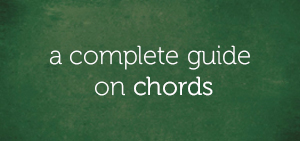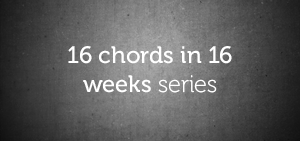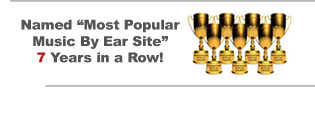You arrived at this page because you’re interested in learning the top 6 chords you need in every key.
Every pianist is duty-bound to learn tons of chords and voicings if he wants to meet up the demands of harmonization and accompaniment he/she is faced with in band and solo situations.
As a young pianist, I learned tons of chords ranging from triads, to seventh, and extended chords and also explored several approaches to voicing them, and learned how they are applied as well in all twelve keys.
Therefore, I can categorically tell you that I can relate to the wide spectrum of chords available for the pianist/keyboardist. However, there are top 6 chords you need to learn as a pianist and in this lesson you’ll find them out all in this lesson.
So, if you give me your undivided attention for the next 5 minutes or so, we’ll be exploring these top 6 chords.
Top 6 Chords You Need
Out of all the chords that anyone can play in any given key (let’s say the key of C major):
…there are top 6 chords that you can’t do without and we’d be covering them shortly before I proceed into telling you why they are the top 6 chords.
The 1-Chord
The 1-chord is the chord of the first tone of the scale and it can be a triad, seventh, or extended chord. The 1-chord is very important to the key because it consists of the stable tones in the key: the first, third, and fifth tone.
This explains why the 1-chord is usually played at the beginning or end of a song.
In the key of C major:
…the root of the 1-chord is C:
…and its chord quality is ALWAYS major.
Options for the 1-chord include: the major triad, the major seventh, the major ninth, the major sixth (add ninth), etc.
In the key of C major, here are some of the options for the 1-chord…
The C major triad:
The C major seventh chord:
The C major ninth chord:
The C major sixth (add ninth) chord:
The 2-Chord
The 2-chord is the chord of the second tone of the scale.
In the key of C major:
…the root of the 2-chord is D:
…and its chord quality is ALWAYS minor.
Options for the 2-chord include: the minor triad, the minor seventh, the minor ninth, the minor eleventh, etc.
In the key of C major, here are some of the options for the 2-chord…
The D minor triad:
The D minor seventh chord:
The D minor ninth chord:
The D minor eleventh chord:
The 3-Chord
The 3-chord is the chord of the third tone of the scale.
In the key of C major:
…the root of the 3-chord is E:
…and its chord quality is ALWAYS minor.
Options for the 3-chord include: the minor triad and the minor seventh chord.
In the key of C major, here are some of the options for the 3-chord…
The E minor triad:
The E minor seventh chord:
The 4-Chord
The 4-chord is the chord of the fourth tone of the scale and it can be a triad, seventh, or extended chord.
In the key of C major:
…the root of the 4-chord is F:
…and its chord quality is ALWAYS major.
Options for the 4-chord include: the major triad, the major seventh, the major ninth, the major sixth (add ninth), etc.
In the key of C major, here are some of the options for the 4-chord…
The F major triad:
The F major seventh chord:
The F major ninth chord:
The F major sixth (add ninth) chord:
The 5-Chord
The 6-Chord
The 6-chord is the chord of the sixth tone of the scale.
In the key of C major:
…the root of the 6-chord is A:
…and its chord quality is ALWAYS minor.
Options for the 6-chord include: the minor triad, the minor seventh, the minor ninth, the minor eleventh, etc.
In the key of C major, here are some of the options for the 6-chord…
The A minor triad:
The A minor seventh chord:
The A minor ninth chord:
The A minor eleventh chord:
“Why Do I Need These Top 6 Chords?”
The basic role of a pianist or keyboardist in a band is to harmonize (or provide accompaniment to) a song. Most of the time, the pianist is involved with accompaniment; playing the supportive role by providing suitable harmony for a piece of melody whether played or sung.
The top 6 chords covered in this lesson are derived from the tones of the scale in the major key.
Although there are seven unique tones in the major key, there are top 6 chords because of the 7-chord is not included in the list of top 6 chords because of its activity or tendency to move to another chord when played.
The 7-chord is known as the leading note chord and differs from every other chord in the key.
The Concept Of Chord Progressions In Popular Songs
The movement of chords from one degree of the scale to another produces chord progressions. In the key of C major:
…there are seven unique degrees. However, chord progressions entail the movement from between any of the chords (the 1-chord, 2-chord, etc.) save for the 7-chord (aka – “the leading note chord”).
Most of the popular songs you’ve heard are basically structured using these top 6 chords and most of the time, the chords used are triads.
“Check Out This Example Below…”
Example – See You Again
It’s been a long (6-chord):
…day with (1-chord):
…out you, my (4-chord):
…friend, and I’ll (1-chord):
…tell you all a- (6-chord):
…bout it when I (1-chord):
…see you a- (4-chord):
…gain (1-chord):
Final Words
Using the top 6 chords covered in this lesson, you can accompany most of the songs you know on the keyboard.
In a subsequent lesson, we’ll be talking about other chord classes that complement these basic chords and how they are applied in chord progressions and songs.
See you then!
Chuku Onyemachi
Latest posts by Chuku Onyemachi (see all)
- The Formation Of Diminished Seventh Chords Used To Be Challenging Until I Did This
- How To Form Seventh Chords In Two Shakes Of A Dog’s Tail Using Third Intervals And The Circle Of Fifths Chart
- I Played The 13sus4 Chord And This Happened…
- How To Build Seventh Chords Like An Architect Using “Foundation And Structure” Concept
- This 4-Week Plan Will Help You Master All The Major Scales







Comments on this entry are closed.